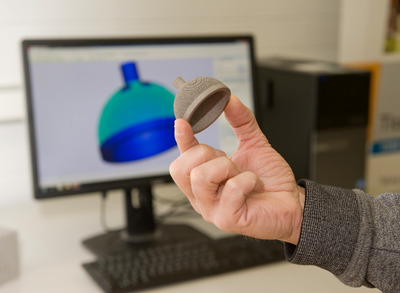CSIRO leads additive manufacturing charge with new titanium facility
CSIRO has announced the opening of a new titanium additive manufacturing facility that will be used for developing advanced titanium parts for aerospace, medical, automotive and manufacturing applications.
The facility houses the first Arcam additive manufacturing machine - which uses electron beam melting to fuse metal powders into complex shapes layer by layer - in the Southern Hemisphere. The system creates 3D parts from metals including titanium alloys, nickel and hard steel alloys.

CSIRO’s expertise in titanium manufacturing includes electron beam melting, cold-spray and thermally assisted machining. The new facility is part of CSIRO’s Future Manufacturing Flagship.
“Additive manufacturing is an emerging technology capable of changing the future of manufacturing in Australia and we are keen to facilitate the adoption of new technologies which will benefit Australian businesses,” the director of CSIRO’s Future Manufacturing Flagship, Swee Mak, said.
“We have invested in a suite of technologies and research which, combined with our links with RMIT and Monash University, provide industry with a unique opportunity to explore and engage in forward-thinking design and production techniques.”
CSIRO has identified additive manufacturing as a key opportunity for the manufacturing sector in Australia and has expertise in core supporting technologies, including materials science, polymer science and metal fabrication.
Industrial commercial additive manufacturing activities CSIRO is engaged in include the development of titanium pipe with Future Titanium Technology (formerly Frontline Australasia) and the production of aerospace hardware through the Joint Strike Fighter program with Ferra Engineering.
“Additive manufacturing has been used for rapid manufacture of prototypes where its speed of production is advantageous. It can also be used for manufacture of complex, high-value components for industrial applications and is especially useful for short production,” said titanium research leader in the Future Manufacturing Flagship John Barnes.
“Companies that want to take on additive manufacturing face a number of practical challenges. We’ve been providing technical advice to solve problems and helping businesses to access these technologies for nearly 10 years now.”
The titanium research facility will be showcased to industry at an ‘open house’ event on 5 December at CSIRO’s Clayton site.
Microplastics found to alter the human gut microbiome
Microplastic-treated cultures showed a consistent and significant increase in acidity (lower pH...
Sustainable, self-repairing, antimicrobial polymers developed
From medicine to electronics and optics, new materials developed by scientists at Kaunas...
A better way to create conductive polymers
New research disproves the longstanding belief that to create conductive polymers, substances...





